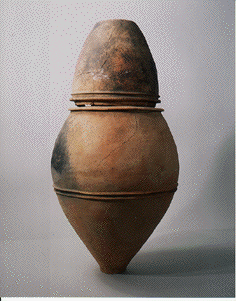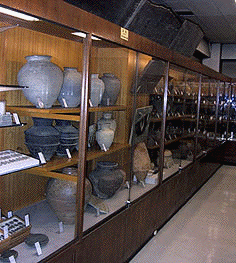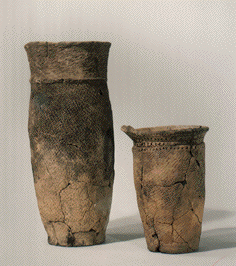The Outline of the Archaeological
Museum of Kokugakuin University
The museum was established by Dr. Kiyoyuki Higuchi in 1928. Since then, it plays a crucial role to help develop archaeology and museology in the university.
The Museum Collection
The museum houses more than eighty thousand archaeological materials and normally three thousand of that are exhibited. Not only collects the museum domestic relics, but allso stores folk, ethnologic and foreign archaeological materials.

The Palaeolithic Era
The museum comprehensively stores archaeological remains dug from the Shirataki site (Hokkaido), the Omekura archaeological site (Nagano) and the Kosaka archaeological site (Nagano).
The Jomon Period
The museum is characterised by more than twenty thousand of Jomon materials. The museum preserves several rare relics: one of them is an incipient-Jomon pottery decorated with slender clay ridges excavated from the Ishigoya Cave site (Nagano). A wide variety of relics from different time in the Jomon period are exhibited in the museum. For example, relics from the Hanatoriyama site in the early Jomon era, the Nogawa site (Kanagawa) and the Tsuchihashi site in the middle of the Jomon period and the Ohno site (Akita) in the late Jomon period. Moreover, the museum stores clay earrings, stone accessories, clay plates and clay figurines.

Jomon Pottery( BC.6000) East Japan
The Yayoi Period
Dotaku (ancient Bronze Bell) is a unique relic in the Yayoi period. The museum has a widely-known crossed-bands pattern Dotaku (Kesadasuki Dotaku) (probably from the Ohiwayama site, Shiga) and the oldest iron axe in Japan from the Saitoyama site (Kumamoto). In addition to these, a large number of earthenwares in the early Yayoi period from the Okatsukoku site (Kanagawa) and the Hirasawa site (Kanagawa).


銅鐸(Bronze Bell) 甕棺(coffin Pottery) North KyushuThe Kofun Period
The museum stores a stone pillow, which is designated as an important cultural property, from the Anegasaki Hutagotuka burial mound (Chiba) and an imitation of real objects made from talc from the Hitachi Kagami Tuka burial mound (Ibaraki). Visitors also can explore a bronze mirror with sacred people and animals along the outer edge, several Chinese mirrors in different period, a pottery with human face and rising hands (the Katayama site, Nagano), clay replicas of various objects (the Senda site, Shizuoka and Tsutoruba site, Chiba) and stone replicas made of talc (the Tatehokoyama site, Fukushima). The museum exhibits a wide variety of relics such as terracotta Sumo wrestler and warrior.

埴輪 Haniwa (Clay Figurine in a Burial Mound)
The Historic Period
The museum preserves various relics from the Shimosoga site (Kanagawa), roof tiles of provincial Buddhist temples in several areas in Japan, potteries from the medieval Seto, Tokoname and Shigaraki kilns, a burial urn, sutra mound and steles. Objects from the pre-modern period such as a notice board and a water pipe of Edo Aoyama waterworks can also be seen in the museum.
Foreign Relics
Foreign relics in the museum are mainly from China and the Korean Peninsula. Archaeological materials in the Neolithic Age, an oracle bone inscription in the Yin dynasty, ceramics in the Han dynasty, objects made for burial with the dead, old money, bronze and a cupper drum are exhibited in the museum. Several archaeological materials from Philippine, Thailand, Indonesia, islands in the Pacific Ocean and the North and South America can be seen in the museum. Tools for hunting, fishing and living are also stored in the museum.

Ceramics 12〜15c Japan Bronze Durums 12c China
Visitors Time
Open Day:Monday to Saturday
Open Time:09:00〜17:00
Close Day:Summer and Winter Vacation of University
and University Closed Days.
Return to TOP Page




